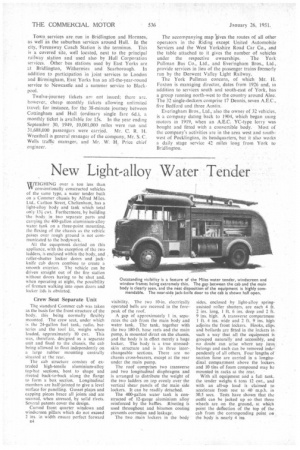New Light-alloy Water Tender
Page 38

If you've noticed an error in this article please click here to report it so we can fix it.
WEIGHING over a ton less than VV conventionally constructed vehicles of the same type, a water tender built on a Commer chassis by Alfred Miles, Ltd.. Carlton Street, Cheltenham, has a light-alloy body and tank which total only 134 cwt. Furthermore, by building the body in two separate parts and carrying the 400-gallon aluminium-alloy water tank on a three-point mounting, the flexing of the chassis as the vehicle passes over rough ground is not communicated to the bodywork.
All the equipment. Carried on this appliance, with the exception of the two ladders, is enclosed within the body, and roller-shutter locker doors and jackknife cab doors combine to create a smooth exterior. The vehicle can be driven straight out of the fire station without doors having to be shut and. when operating at night, the possibility of firemen walking into open doors and locker lids is obviated.
Crew Seat Separate Unit
The standard Commer cab was taken as the basis for the front structure of the body. this being normally flexibly mounted The crew seat, under which is the 24-gallon fuel tank, radio, batteries and the tool kit, weighs when loaded, approximately 10 cwt. This was, therefore, designed as a separate unit and fixed to the chassis, the cab being allowed to float independently on a large rubber mounting centrally situated at the rear.
The cab structure consists of extruded high-tensile aluminium-alloy top-hat sections, bent to shape and riveted back-to-back along the flange to form a box section. Longitudinal members are half-jointed to give a level surface for panelling. Gusset plates and capping pieces brace all joints and are secured, when stressed, by solid rivets. Sev,:ral patents cover the design.
Curved front quarter windows and windscreen pillars which do not exceed 2 ins, in width ensure perfect forward n4 visibility. The two 10-in, electrically operated bells are recessed in the forepeak of the roof.
A gap of approximately 1 in. separates the cab from the main body and water tank. The tank, together with the two 180-ft. hose reels and the main pump, is mounted direct on the chassis, and the body is in effect merely a huge locker. The body is a true stressedskin structure and is in three interchangeable sections. There are no chassis cross-bearers, except at the rear under the main pump.
The roof comprises two transverse and two longitudinal diaphragms and is arranged to distribute the weight of the two ladders on top evenly over the vertical shear panels of the main side lockers. It can be readily detached.
The 400-gallon water tank is constructed of 12-gauge aluminium alloy reinforced by the baffles. Riveting is used throughout and bitumen coating prevents corrosion and leakage.
The two main lockers in the body sides, enclosed by light-alloy springassisted roller shutters, are each 4 ft. 2 ins. long, 1 ft. 6 ins, deep and 2 ft. 9 ins. high. A transverse compartment 1 ft. 4 ins, wide and 2 ft. 9 ins, high adjoins the front lockers. Hooks, clips, and bollards are fitted in the lockers in such a way that all the equipment is grouped naturally and accessibly, and no doubt can arise where any item, belongs and each can be removed independently of all others. Four lengths of suction hose are carried in a longitudinal compartment above the lockers and 10 tins of foam compound may be mounted in racks at the rear.
With all equipment and a full tank. the tender weighs 6 tons 12 cwt., and with an all-up load is claimed to accelerate from rest to 40 m.p.h. in 30.5 secs. Tests have shown that the outfit can be jacked up so that three wheels are on the ground, at which point the deflection of the top of the cab from the corresponding point on the body is nearly 4 ins




















































































